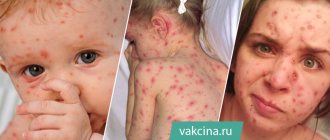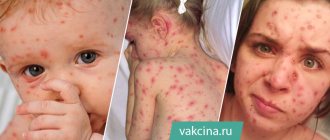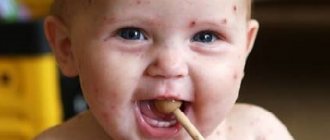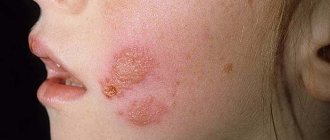A little about chickenpox
Chickenpox (varicella) is a viral disease transmitted from a sick person by airborne droplets. It has distinctive features, which greatly facilitates diagnosis. Chickenpox is characterized by the appearance of skin rashes that go through several stages in their development, after which the disease gradually subsides.
Chickenpox is predominantly a childhood disease, since 90% of those who have been ill are children under 14 years of age. But adults can also get chickenpox if they avoided it in childhood.
Properties of the chickenpox virus
Varicella Zoster is a virus that, when it enters the human body, provokes the development of chickenpox. It belongs to the group of herpes viruses, due to which it has a certain property. This pathogen no longer leaves the body into which it entered, being located in the nerve ganglia. Moreover, he may not remind of himself for a long time. But if this virus is reactivated (with decreased immunity, stress and exhaustion), then it causes another disease - shingles.
The virus cannot exist in our environment, so it dies quickly. But it is known that you can become infected with it due to its spread.
When a person suffers chickenpox, a strong immunity is formed in his body, which lasts for life. This is why it is very unlikely that you will get chickenpox again.
How to properly care for a sick child?
This virus is very contagious , so first of all it is necessary to isolate the child from healthy brothers and sisters. During an exacerbation, do not walk. In this case it is necessary:
- constantly ventilate the room in which the child is located;
- try to distract the child from itching with games, reading books, etc.;
- dress the child in light clothes made of cotton and other natural fabrics to avoid the “greenhouse effect”;
- change bedding more often.
To reduce itching and relieve inflammation, you need to wash your child - give him a cool bath with herbal infusions. It is necessary to exclude hot, hard, spicy foods and foods that are potential allergens from the diet. If the child does not want to eat, offer him milk or tea with herbs. The diet should be light - pureed vegetables and fruits, soups, fermented milk products.
Features of the newborn's body
In babies, the body has many characteristics, since it is still actively developing and adapting to new conditions. Chickenpox in newborns is a rare occurrence. Why?
The child’s own immune system is still weak. But all the necessary antibodies that will cope with pathogens of a variety of diseases come to him through mother's milk. It is known that milk has such a protective function for the first six months, and at approximately 6 months the baby’s body begins to independently fight microbes.
Possible complications from the disease
Usually the disease is not severe. However, complications may still arise:
- skin infections due to bacteria entering open wounds at the site of burst blisters, usually staphylococcus and streptococcus;
- pneumonia, usually viral, but sometimes bacterial;
- damage to the central nervous system - from aseptic meningitis to encephalitis;
- encephalitis – in 10-20% of cases leads to death, and chickenpox meningitis can occur along with it.
- rare complications - thrombocytopenia, Guillain-Barré syndrome, myocarditis, orchitis, arthritis, hepatitis, iritis, uveitis.
When can a baby get chickenpox?
Chickenpox in infants is still possible. But this requires the presence of the following factors:
- The baby was born with a very weak immune system (for example, he has congenital immunodeficiency).
- Lack of breastfeeding, early introduction of formula.
- Mom did not have chickenpox.
- A pregnant woman suffered from chickenpox while carrying a baby, or she fell ill during childbirth.
Chickenpox in infants has its own characteristics, because their immune system is not yet perfect. Various complications or other diseases may occur against the background of the main one. Therefore, it is necessary to protect the baby as much as possible, and in case of infection, consult a doctor in a timely manner and follow all instructions.
Varieties of chickenpox
Depending on the severity, the disease can be mild, moderate or severe. It can occur in atypical and typical forms.
Atypical forms:
- hemorrhagic – occurs against the background of thrombocytopenia, often provokes bleeding;
- gangrenous – against a background of weakened immunity can lead to sepsis;
- pustular - occurs against the background of the addition of bacteria;
- visceral – typical for patients with immunodeficiency, often ending in death;
- rudimentary - occurs easily, is diagnosed in children who received immunoglobulin during the incubation period.
There are also very mild forms of the disease, when children do not have fever and the rash is sporadic (on the back and stomach). It is usually discovered when children are examined in kindergarten during an epidemic.
Pregnancy and chickenpox
Adults do not tolerate chickenpox as easily as younger children. But doctors are especially afraid for pregnant women who have not yet had time to get sick. This disease can have a negative impact on the fetus (if the woman herself becomes ill for the first time), so blood tests for pregnant women must include an analysis for antibodies to the varicella zoster virus.
Depending on the stage of pregnancy, the virus affects the health of the fetus in different ways. In the first trimester, the damage will be very serious (the narnar system, eyes, skin suffers), and the risk of death is high. The disease in the second trimester of pregnancy can lead to various malformations of the baby. In the third trimester, the degree of exposure to the fetus decreases, but there may also be consequences.
There is such a thing as “congenital chickenpox in newborns.” It occurs in a quarter of cases after the expectant mother gets chickenpox, and the fatality rate is approximately 20%. With congenital chickenpox, children experience developmental disorders; many children develop various neurological disorders. If the virus has been detected in the body of a newborn, then timely prescribed antiviral treatment will produce results.
How does the disease progress?
There are 4 periods of the disease: incubation period, prodrome period, clinical manifestations, recovery. It is possible to determine that it is chickenpox only during the period of clinical manifestations, which is accompanied by specific skin rashes.
In children under one year of age, the incubation period is shorter - about 7 days pass from the moment of infection to the appearance of the rash. At this time, the baby may experience a rise in temperature to 38 degrees, lethargy, decreased appetite, and bad mood. In general, the symptoms resemble those of a viral disease.
Skin rash
It is thanks to skin manifestations that chickenpox is diagnosed without unnecessary difficulties. The rash goes through several stages in its development: spot, papule, vesicle, crust.
- First, a red spot appears on the skin, which indicates the reaction of the immune system to the virus in the body.
- During the inflammatory process, a tubercle (papule) is formed.
- Then, intercellular (serous) fluid is released, causing the top layer of skin to separate from the underlying layers and form a vesicle with clear fluid (vesicle). When scratching the vesicles, the virus enters the skin, which provokes the appearance of new elements of the rash.
- When the vesicles dry out, a crust forms in their place. If it is torn off while combing, scars may remain in this place.
The skin rash is accompanied by severe itching, but everything possible must be done to prevent the baby from scratching the rash.
Symptoms
The main symptoms of chickenpox are typical. These include:
- increase in body temperature to subfebrile levels (less often to febrile);
- the appearance of papulovesicular rashes throughout the body;
- symptoms of general malaise (weakness, drowsiness, etc.).
Symptoms appear after the incubation period has passed, which usually lasts 5-7 days, but can sometimes last two weeks. The rashes characteristic of this disease appear first on the face and then spread throughout the body - appearing on the arms, chest and back, and lower extremities.
At first, the rashes appear as small blisters that itch and itch. Then the bubbles burst and a weeping surface forms underneath. At the final stage, the blisters become covered with a crust, which should never be torn off, as scars may remain.
Chickenpox treatment
Chickenpox in children under 1 year of age is treated in almost the same way as in the older population. Treatment is prescribed depending on the severity of the disease:
- Antiviral therapy is carried out in a hospital setting for severe chickenpox.
- In turn, mild and moderate-severe degrees can be easily cured at home.
If the high temperature persists for a long time, it can be brought down with the help of antipyretics (for example, before bedtime). But you should remember that antibodies to the chickenpox virus are produced precisely at elevated temperatures, so there is no need to lower it all the time. In any case, it is necessary to treat the child as prescribed by the doctor, and also ask what is best to do in this or that case. For example, some pediatricians prescribe antihistamines instead of antipyretics.
In the event that a child develops complications (widespread rashes on the mucous membranes, bacterial infection, inflammatory processes in internal organs), he will be sent to a hospital, where he will be under the close supervision of doctors and receive appropriate treatment.
Chickenpox in an infant requires adherence to a home regimen. It is necessary to ensure that the baby does not become dehydrated. You can give him water, tea or compote to drink. In this case, skin care plays a big role.
How to care for your baby's skin?
It is difficult to explain to a child under one year old that it is impossible to scratch the elements of the rash. He will still try to get rid of the itching in this way, and this will lead to the spread of the virus and the formation of new rashes. Therefore, parents need to ensure that these actions are kept to a minimum. Your baby can wear gloves that will soften the impact on the skin. To prevent the itching from increasing, you need to regularly ventilate the room, monitor the temperature in it, and also make sure that the child is not hot (sweat irritates the skin, which increases the discomfort).
To make it easier to track what stage a baby’s chickenpox is at, you can use brilliant green. It does not speed up recovery, but it helps to visually identify new rashes and also relieves itching a little.
You don't have to completely give up bathing. The main thing is not to rub the skin after this, so as not to disrupt the integrity of the vesicles with serous fluid. You also need to remember to regularly change bed linen and clothes.
Content
- Pathogen information
- Cause
- Varieties of chickenpox
- Chickenpox symptoms
- Diagnostics
- How to properly care for a sick child?
- Consequences
- Possible complications from the disease
- Chickenpox vaccination
Chickenpox is a highly contagious viral disease caused by a type of herpes. Most often it affects children and schoolchildren. In children, chickenpox occurs in a relatively mild form, causing complications in very rare cases. After recovery, immunity to the disease appears, but the herpes virus remains in the body forever. In adulthood, it manifests itself in the form of herpes zoster.
Prevention of chickenpox in children
If there are older children in the family, then it is unlikely that it will be possible to protect the baby from chickenpox. In this case, you can try to limit their contact, and also carry out wet cleaning and ventilate the room more often. Knowing that one of your relatives or friends is sick, it is better to refuse meetings for the period of their illness.
There is the possibility of prevention with a vaccine, but it is carried out as prescribed by a doctor. For example, it is recommended to vaccinate women who are planning a pregnancy but have not yet had chickenpox. And pregnant women who become ill while carrying a child are given immunoglobulin to reduce the impact of the virus on the fetus.
The most important thing is to be attentive to the baby’s health, consult a doctor in a timely manner and follow his recommendations. In this case, you can avoid unpleasant consequences.











